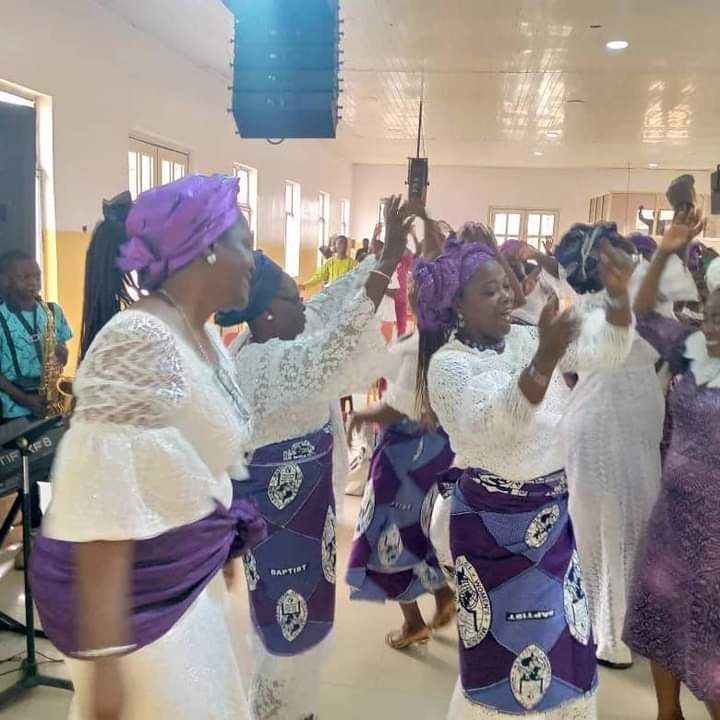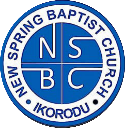
Baptist Women’s Missioanry Union of Nigeria comprises four organisations. These organisations take care of the spiritual, physical and intellectual aspects of womanhood from cradle to the grave. Each of these organisations has its name, functions, programmes and literature to fit the group. The groups are:
- Sunbeam Band
- Girls’ Auxiliary
- Lydia Auxiliary
- Women’s Missionary Society (WMS).
WOMEN MISSIONARY SOCIETY
Women’s Missionary Society (WMS) is an organisation for Baptist married women of all ages.
History
Historically, the organisation is as old as WMU. In the early years, Baptist churches were used to having societies. For instance, in 1896, Araromi Baptist Church, Lagos had women societies like Missionary Band, Young People’s Society; in 1915, First Baptist Church, Lagos had societies such as Women’s Preachers’ Band, Morning Star and Aged Women’s Association; in 1916, 94 women from three churches in Lagos gingered by Dr. Agbebi formed “Baptist Women’s League; in July 1916, at Oke’lerin Baptist Church, Ogbomoso, five women’s societies came together – “The Grandmothers”, “The Mothers”, “Purity Society”, “Esther” and the ‘Stars’ all dressed in white attire – as forerunners to the formation of WMU. On March 14, 1919, the Women’s Missionary League was inaugurated by eleven women representing nine western towns. They had a separate meeting presided by Mrs. E.C. MacLean (A Southern Baptist Missionary) under an ackee apple (Ishin) tree at Osupa Baptist Day School, Ogbomoso during the 6th Annual meeting of the Nigerian Baptist Convention. The women assembled outside in an open space illuminated by God’s natural light.
Purpose
WMU mainly exists for missions. She does this through her purpose which is to build lives that will emulate the Spirit of our Lord and Saviour Jesus Christ and promote Christian Missions through her organisations and fundamentals. This purpose is broken down into the following bitable pieces:
- to participate in private and public prayer
- to conduct regular personnal and corporate Bible study
- to plan strategic and systemic giving
- to engage in missions by praying, giving and going to support the Convention
In line with the above, WMS is set to:
- Empower every member for Kingdom growth through in-depth Bible study and prayer;
- Impact Christian leadership qualities on members in order to influence their homes by being good wives to their husbands, exemplary mothers to their children, and useful vessels in the church, community and society;
- Support, finance and mentor young people’s organisations (Sunbeam, GA, Lydia). It is from WMS that workers and advisers are chosen to mentor these Young People’s groups;
- Raise godly women who will use their human and material resources to promote Kingdom work and growth here on earth; and
- Prepare women for the Kingdom of God.
These objectives are achieved through weekly meetings in churches, quarterly in associations and annually in conferences, Leadership Workshops, Camps and Retreats. Proclaim magazine is used for weekly meetings. Some of the retreats organised at the Convention level include the following: Hannah’s Retreat (for waiting mothers), Widows’ Retreat, Executive Women’s Retreat for professional women who are at the peak of their careers, World Day of Prayer, Africa Day of Prayer, Mothers’ Day, Focus Week among others. Needs of women are being met during these programmes and there are tremendous testimonies to God’s glory.
Watchword
Our watchword is “Labourers together with God” (1 Corinthians 3:9), while our permanent hymn is “Come, Women Wide Proclaim“.
Colour
Our colours are white, purple and gold.
LYDIA AUXILIARY
Lydia Auxiliary started as Young People’s group in 1946 under the leadership of Mrs. Rebecca Taiwo (1946-1947) and subsequently by Miss Bykota Ebun Omikunle (1948-1949) and Miss Ibidun John (1951), respectively. In 1952, the Young People’s group metamorphosed into Lydia Circle where young ladies were separated from younger girls. The reason for this was to help in ministering to the needs of ladies from 17 years of age (who has never been married neither has given birth to any child).in higher institutions, businesses and other life vocations. This is to stimulate interest in missions, to emphasise Christian living, to encourage daily Bible reading and prayer, bringing together all young women for the purpose of fellowship and witnessing and also to train in the art of soul winning; thereby building eligible members of WMS after marriage.
Lydia Watchword
The Watchword adopted is Acts 26:18a: “To open their eyes and to turn them from darkness to light . . .” with the hymn Hark the Voice of Jesus Calling.
Lydia Colours
The colours of the Lydia Auxiliary are purple and white. Purple symbolises royalty. In ancient times, kings and queens chose to appear in purple colour. Lydias are daughters of the King of kings. White symbolises purity. It is very important that a Lydia be clean, pure and upright with high level of moral standing in every way.
Ideals
These are the ideals of the Lydia Auxiliary:
- Study of missionary message of the Bible
- Prayer for missions and missionaries
- Devoted personal service activities for the spiritually and physically needy
- Regular giving to worldwide missions
Uniform
Lydia Auxiliary organisation was recognised with a purple gown taped with white, a white belt and a cap worn with a white pair of socks and canvas modeled at the Jos Convention in 1985. In 2014, a new uniform was introduced; a white shirt on a purple skirt with a beret, a thin white belt, with newly customised sock worn in a white canvas. A Lydia is expected to be neatly dressed as a peculiar treasure representing the Most High. The circle was organised in 1952 under the leadership of Miss Mary Ellen Yancey (1952-1955). When Miss Yancey went on furlough, Miss Aduke Akinwumi (later Mama Aduke Akinola) served as the leader of the circle between 1955 and 1956 before Miss Yancey returned to continue from 1957 to 1961. Miss Yancey served as the Lydia Director with Miss Abiola Adewole as the Lydia leader (1959-1960) and Miss D. I. Akumagba (1961-1962). In preparing the Guidebook (first print 1964), the committee charged with the responsibility recommended the change from Circle to Auxiliary. This recommendation was accepted and the organisation hitherto has been called the Lydia Auxiliary.
Lydia Awards
Lydia Awards offer challenging opportunities for excelling in missionary service. The service and honour awards are recognition of an individual member of Lydia Auxiliary who has grown in missionary service by meeting the requirements listed in the Guidebook. The service Award must be completed before a lydia can begin working on the honour award. About 10 to 15 Lydias used to qualify for Service and Honour Awards at the beginning. The missionary award project was introduced in the late 80s. In the year 2000, 1,259 Lydias completed the service award, 545 for the honour award while 256 qualified for the career missionary award.
GIRLS AUXILIARY
Girls Auxillary is the WMU organization for girls between ages 10 and 16 years. This comprises of two groups:
- Junior age: 10-12
- Intermediate age: 13-16
One of the pioneers of the Girls Auxiliary work in WMU of Nigeria was Mrs. Carson (SBC missionary). In 1922, she gathered girls who were too old for the Sunbeam Band to form Girls Association which was later changed to Girls Auxiliary the same year. Few officers were elected among them to lead: Miss Grace Emokpae (later Mrs. Sagie) who was one of their leaders then. In Ogbomoso, Miss Young also promoted girls who were too old for the Sunbeam Band to GAs. They were meeting once in a month on Sundays and later the enrolment grew to 22. Only two or three could read and there was no literature organised by Mrs. Carson. The main programme was to act Bible stories.
In 1924, there were nine (9) Girls Auxiliary in Ijora, Awe, Ode-Omu, Ibadan, Iresi, Ikire, Abeokuta Girls’ School, Igbajo and Ogbomoso with enrolment of 149. Fifty-six of them could read the Bible. The Girls Auxiliary organisation was officially recognised as a part of WMU family in 1925. The theme for that year was Thirty-five Events in the Life of Christ, though had the same hymn and watchword with the Young Women’s Association – ‘O Zion Haste’ and Daniel 12:3, respectively. The watchword “Arise, shine: for thy light is come, and the glory of the LORD is risen upon you” (Isaiah 60:1) for that year becomes the G.A. permanent watchword
SUNBEAM BAND
Sunbeam Band is one of the four organisations under Women Missionary Union. It provides early Christian education to children (Mark 10:13-16; Mark 9:36-37).
Grouping and Membership
The division of children into different age groups has contributed to the growth of Sunbeam Band. In previous years, WMU Handbook states that children from three through twelve years of age were eligible members of Sunbeam Band. 1953 began the division of children from four through nine years. Few years later, the grouping provided for
- Beginner Sunbeam Band – ages 4 to 6 years
- Primary Sunbeam Band – ages 7 to 9 years.
The Sunbeam (boy) graduates at the age of 10 to the Royal Ambassador while Sunbeam (girl) graduates to the Girls Auxiliary.
Ungraded Sunbeam Band
The ungraded Sunbeam Band is the combination of both Beginner and Primary Sunbeams between ages 4 and 9 years.
Sunbeam Band Aims
The fundamentals of Women’s Missionary Union are the five shining aims of the Sunbeam Band organisation. The children can understand the aims easily if they learn in pantomime:
- Talking with our heavenly Father (Clap hands together as in prayer);
- Hiding God’s Word in our hearts (Cross hands and place them on chests to signify our hearts);
- Learning about the children of the world (Place hands together with palms up to make a book);
- Helping others for Jesus’ sake (clap hands with the person next to you);and
- Giving money to help preaching the Gospel (Extend hands, fingers dropping as in act of giving).
The Bible is the basic tool for teaching Sunbeams. Teaching materials such as maps, pictures and other helps cannot take the place of the Bible.
Sunbeam Band Programmes
All Sunbeam Band programmes focus on mission. Their programmes and activities include
- the Mission Study programme
- Day Camp
- Weekly Meeting Programme
- Bible Memory Drill
- Sunbeam Week.
They acquaint children with other people around the world and create in every child the desire to love God more and to meet the needs of people. After observing Sunbeam Band activities as recommended by the BWMU Headquarters, the report booklet is filled and sent to the Headquarters, listing names of the children and their offering. When children are taught and led to love Jesus and others, they usually get busy doing so in later years. They are taught personal service and stewardship of their time, talents and treasures.
Sunbeam Band Colours:
Sunbeam Band colours are: gold or yellow, sky-blue and white. Gold stands for “heaven bound“, sky-blue stands for love that we have for Christ while white stands for purity.
